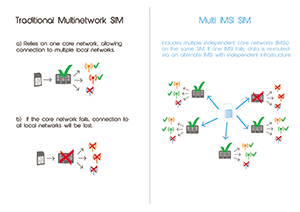There is a lot of discussion around the Internet of Things relating to the lack of standards and managing Big Data, but very little about what is actually at the heart of the IoT: connectivity.
A recent report by Machina Research highlights the challenges the explosion of IoT devices will cause Mobile Network Operators (MNOs). The conclusion is clear; networks are not currently structured to deal with the demands of the IoT, particularly mission critical applications that require maximum reliability. In reality, even if networks were able to quickly scale to meet these demands, relying on one network for global connectivity of mission critical devices is an increasingly risky proposition.
Network pressures
IoT applications for emergency services or healthcare rely on real-time data being sent consistently back to a server, wherever they are located. They behave differently to consumer devices, since they send regular traffic at all times of the day and night. Whilst networks are designed to cope with occasional data peaks, these are usually based on traffic generated by consumer devices. As IoT applications increase, so will the pressure on networks, making them more susceptible to congestion and downtime which is unacceptable for mission critical applications.
Unfortunately, no network is 100% reliable. Technical issues can cause outages which are disastrous for any application. Global connectivity is often provided by a core network with local network agreements in each country. Pricing is therefore dependent on these agreements which are subject to constant fluctuation. These issues could ultimately result in loss of connectivity or the need to swap out the SIMs, a costly exercise especially if devices are located in inaccessible areas. Moreover, many device manufacturers are now using embedded SIMs which require direct control over the profile of the SIM card. The ability to update the connectivity options as market conditions change is essential.
As more devices connect to mobile networks this situation will be exacerbated, so what can developers of IoT applications do to ensure that their connectivity is not compromised by the growth of the IoT itself?
Achieving no single point of failure
The most important requirement for any mission critical application is redundancy. The ability to remotely re-route the data via alternative independent networks is essential to avoid potential problems. The “holy grail” is a no single point of failure solution, whereby the SIM is not only able to connect to multiple networks in each country, it can also swap between different “core” networks on completely separate infrastructures.
Multi-IMSI SIMs go some way to achieving this, however many of these depend on a core IMSI on the SIM, to which relevant IMSIs are sent from the network Home Location Register (HLR) when the device enters a country. This creates additional points of failure, e.g. the HLR or the USSD message used to send the IMSI to the SIM.
The only way to ensure full redundancy is by storing the IMSIs on the SIM card itself. If this solution is combined with an application enabling the SIM to automatically swap between IMSIs when signal is lost, and an Over-The-Air (OTA) platform to remotely swap or add IMSIs to the SIM profile, the solution will not only be redundant, it will also be future proof. As pricing and coverage change, new IMSIs are added to the SIM OTA, and the SIM can remain in the device without the need for expensive SIM swaps or device rebuilds.
 This built-in redundancy will allow mission critical applications to grow with the IoT, instead of being hindered by it.
This built-in redundancy will allow mission critical applications to grow with the IoT, instead of being hindered by it.
By Charles Towers-Clark, Managing Director of Podsystem Group
As well as strategic planning and corporate governance Charles has direct responsibility for customer service.










